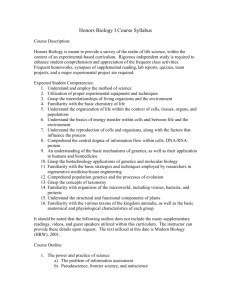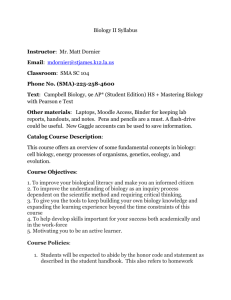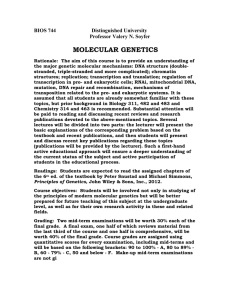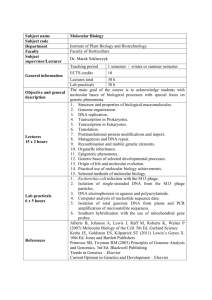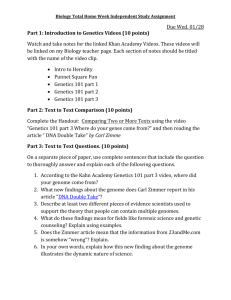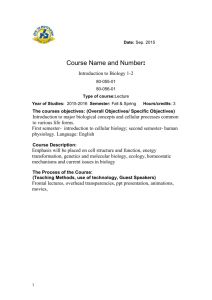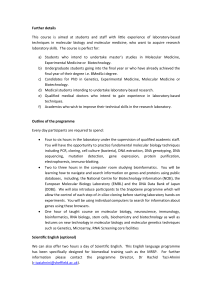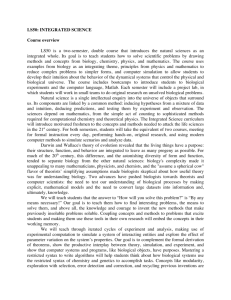Honors Biology I Course Syllabus
advertisement
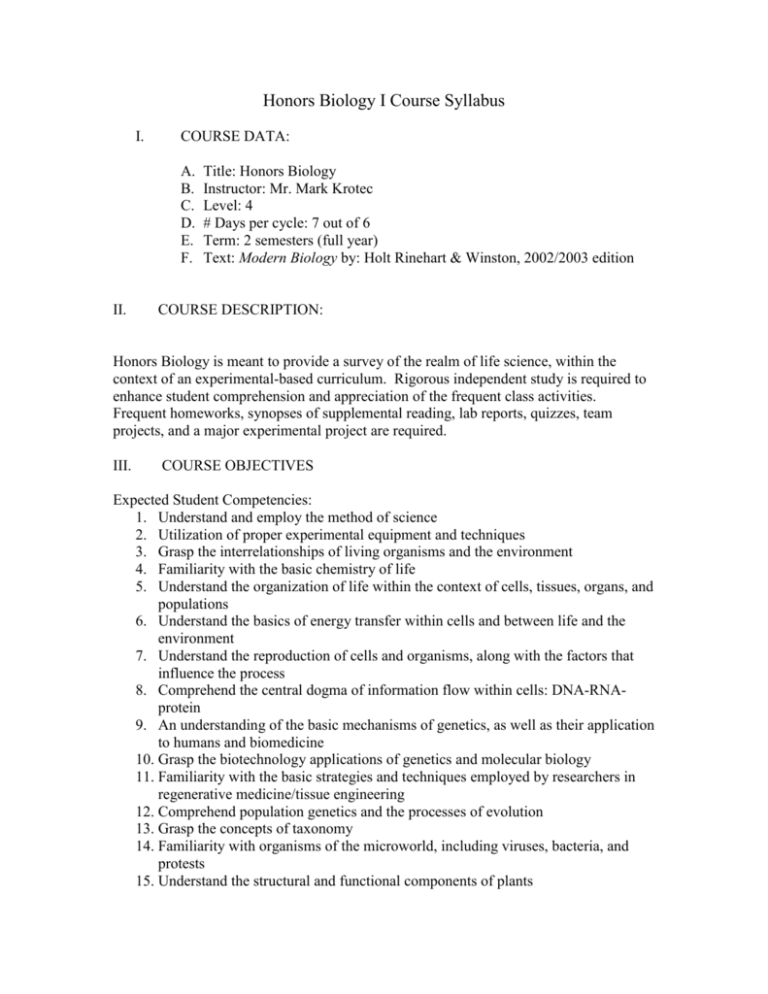
Honors Biology I Course Syllabus I. COURSE DATA: A. B. C. D. E. F. II. Title: Honors Biology Instructor: Mr. Mark Krotec Level: 4 # Days per cycle: 7 out of 6 Term: 2 semesters (full year) Text: Modern Biology by: Holt Rinehart & Winston, 2002/2003 edition COURSE DESCRIPTION: Honors Biology is meant to provide a survey of the realm of life science, within the context of an experimental-based curriculum. Rigorous independent study is required to enhance student comprehension and appreciation of the frequent class activities. Frequent homeworks, synopses of supplemental reading, lab reports, quizzes, team projects, and a major experimental project are required. III. COURSE OBJECTIVES Expected Student Competencies: 1. Understand and employ the method of science 2. Utilization of proper experimental equipment and techniques 3. Grasp the interrelationships of living organisms and the environment 4. Familiarity with the basic chemistry of life 5. Understand the organization of life within the context of cells, tissues, organs, and populations 6. Understand the basics of energy transfer within cells and between life and the environment 7. Understand the reproduction of cells and organisms, along with the factors that influence the process 8. Comprehend the central dogma of information flow within cells: DNA-RNAprotein 9. An understanding of the basic mechanisms of genetics, as well as their application to humans and biomedicine 10. Grasp the biotechnology applications of genetics and molecular biology 11. Familiarity with the basic strategies and techniques employed by researchers in regenerative medicine/tissue engineering 12. Comprehend population genetics and the processes of evolution 13. Grasp the concepts of taxonomy 14. Familiarity with organisms of the microworld, including viruses, bacteria, and protests 15. Understand the structural and functional components of plants 16. Familiarity with the various taxons of the kingdom animalia, as well as the basic anatomical and physiological characteristics of each group It should be noted that the following outline does not include the many supplementary readings, videos, and guest speakers utilized within this curriculum. The instructor can provide these details upon request. The text utilized at this date is Modern Biology (HRW), 2001. IV. GRADING: Student grades are assigned based on a scale reflecting their mastery as determined by a combination of assessments, including homeworks, lab reports, short papers, quizzes, exams, challenge projects, review games, and a major independent research project. The percentage (scale) grade will then be adjusted to Central’s grading scale. V. OUTLINE OF MAIN TOPICS 1. The power and practice of science a) The problem of information assessment b) Pseudoscience, frontier science, and antiscience c) Building a baloney detection kit d) Science method (chapter 1) e) Statistics and measurement Suggested Activities 1. “The Good, The Bad, and the Ugly”: information assessment 2. Bubbleology lab investigation 3. Paper Towel Efficiency lab investigation 4. X-Files: Paranormal Investigation 2. Ecology and environmental science (unit 5, chapters 19-23) a) Statement of the problem b) Concepts of ecology (chapter 19) c) Organismal relationships (chapter 21) d) Energy transfer (chapter 22) e) Biogeochemical cycling (chapter 22) f) Biomes and the biosphere (chapter 22) g) Populations (chapter 20) h) Environmental science: man and the biosphere (chapter 23) Suggested Activities 1. field analysis 2. biome projects 3. algal growth lab 4. bacterial/yeast population growth lab 5. 6. 7. 8. 9. 10. pollution analysis lab water quality labs smoking effects on cell lab personal impact project land use for food project alternative foods project. 3. The chemical basis of life a.) Basic chemical concepts (chapter 2): atoms, ions, molecules, acids, bases, buffers b.) Biochemistry (chapter 3) and the significance of water c.) The molecules of life: proteins, lipids, carbohydrates, and nucleic acids d.) Techniques and strategies of biochemical researchers Suggested Activities 1. water density lab 2. water characteristics lab activity 3. food analysis lab 4. carbohydrate influence on microbial population growth 5. chromatography lab 6. rainbow spectroscopy 4. Cells: structure and function a) Prokaryotes and eukaryotes (chapter 4) b) Organelles c) How scientists study cells d) Cell transport (chapter 5) e) Osmosis and diffusion f) Molecular transport mechanisms Suggested Activities 1. design a cell activity 2. intro to microscopy 3. cell challenge lab 4. cell staining analysis lab 5. osmosis and diffusion challenge 6. potato/zucchini cell diffusion lab 7. comparative motile apparati lab 5. Energetics and metabolism a) Energy and chemical reactions (chapter 2-2) b) Cellular energy carriers c) Enzymes d) Photosynthesis (chapter 6) e) Cell respiration (chapter 7) Suggested Activities 1. prime time enzyme simulation activity 2. metabolism role playing simulation 3. amylase enzyme lab 4. papain enzyme lab 5. photosynthesis lab, elodea gas production 6. color influence on PS activity 7. yeast respiration lab 8. carbohydrate influence on microbial population growth 6. Cell reproduction a) Chromosomes and DNA packing (chapter 8) b) Cell division c) Cell cycle and molecular controls d) Mitosis and Meiosis Suggested Activities 1. distant nucleotide apogee (D.N.A.) 2. bead simulation of chromosome fates in cell cycles 3. temporal investigation of mitotic phases 7. Central dogma of biology: information transfer a) b) c) d) Brief history of the elucidation of DNA as the molecule of heredity DNA and RNA structure (chapter 10) Transcription and translation Mutation Suggested Activities 1. James Bond: cellular spy activity 2. yeast or bacteria reversion lab: uv light effects on cells 3. double helix construction activity 8. Gene expression a) Prokaryotic expression controls (chapter 11) b) Eukaryotic expression: genome organization and function c) Cancer Suggested Activities 1. CMU lab field trip: Turning genes off and on in bacteria 9. DNA science and biotechnology a) Recombinant DNA technology (chapter 13) b) Molecular applications: probing, knockouts, PCR, antisense, etc. c) Technological potentials: human genome project, transgenic species, etc. d) Bioethics e) Tissue engineering/regenerative medicine (supplemental readings) Suggested Activities 1. CMU lab field trip: creating glow in the dark bacteria 2. plasmid identification lab/electrophoresis 3. transforming cells: blue/white screening 4. RFLP: whose child is it? 5. DNA profile gels: crime busters 6. plasmid cloning and purification 7. bone engineering: build a cell 8. scaffold diffusion assay 9. the precarious balance: scaffold degradation analysis 10. scaffold/growth factor biocompatibility lab 11. immunogenetics of autoimmune disease: PCR profiling 12. stem cell potential: sea urchin development 13. myoblast cell culturing: influencing differentiation 14. scaffold cell seeding efficiency lab 15. bioethics of the biomedical revolution 10. Genetics a) Memdelian inheritance (chapter 9) b) Alternative inheritance modes (chapter 12) c) Human genetics, reproductive counseling, screening, ethics, etc. Suggested Activities 1. planet reebop lab 2. computer genetics labs: cat, dragon etc. 3. create a child lab activity 4. family pedigree project 11. Evolution a) b) c) d) Population genetics (chapter 16) Darwin and the theory of natural selection (chapter 15) Speciation and evolutionary influences Evolution: science vs. pseudoscience, societal implications Suggested Activities: 1. M and M speciation lab 2. immunology and evolution lab 3. evolution of horns and antlers, Carnegie collection lab 4. molecular data reconstruction lab 5. Carnegie field trip: Sol III, and evolutionary perspective 12. Taxonomy a) Systematics and modern phylogenetics (chapter 18) Suggested Activities 1. jellybean taxonomy 2. dichotomous key investigation 13. Microbiology a) Viruses (chapter 25) b) Monerans (chapter 24 c) Protists, Algae, and Fungi (chapters 26-28) Suggested Activities 1. infection/epidemiology simulation activity 2. environmental influence on bacteriophage infectivity 3. bacterial identification 4. bacterial survivorship (soap, antibiotics) 5. second hand smoke effects on microbes 6. microbe poster symposium 7. algal classification 8. protist race lab 9. protist behavior and adaptations 14. Botany a) Life cycles, classification overview (chapter 30) b) Bryophytes and other non-vascular plants c) Vascular plants, gymnosperms and angiosperms d) Plant reproduction (chapter 32) e) Plant structure and function (chapter 31) f) Plant responses (chapter 33) Suggested Activities 1. bryophyte and fern microviewer challenge lab 2. angiosperm structure and function lab (microviewer challenge) 3. sectioning and staining of plant organs lab 4. plant game 5. fast plant responses lab 6. germination and growth influences lab 7. plant adaptations lab (guest lecture) 8. plant poster symposium 15. Zoology a) Survey of invertebrates (chapters 34-40) b) Survey of invertebrates (chapters 41-45) c) Animal behavior (supplementary readings) Suggested Activities 1. planarian, hydra, arthropod behavior lab 2. dissection survey 3. star trek dissection/analysis 4. animal Olympics symposium 5. animal poster symposium 6. zoo field trip activity Due to limited course time, teacher discretion will determine total topics to be covered in this curriculum.
